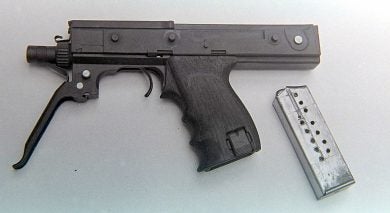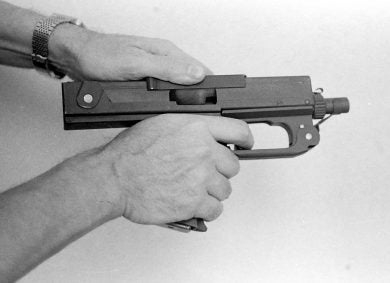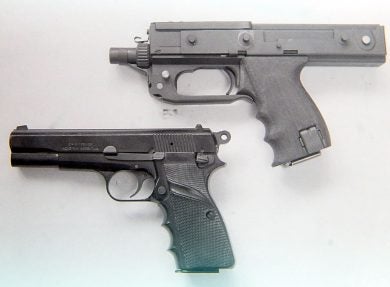The year was 1986, and once again FMAP “Domingo Matheu” was caught playing around with the full-auto pistol concept. The idea at the time was to create a new design to see how it compared with the earlier model, a sort of in-house shoot-out competition. Designer Magin Almara was placed in charge of the new weapon, which was also called simply, and again… the MPA (Mini Pistola Ammetralladora).

The sole Almara-designed MPA full-auto pistol prototype is seen here with a 9x19mm ammo round for size comparison.
Mechanically speaking, both machine pistols were virtually the same, employing similar barrels, receivers and bolts. Changes, however, were evident in the ergonomic approach. Armara’s gun featured an inclined pistol grip midway in the receiver’s length, the magazine (a 15-round job) fitting into it. The release catch was a square button located on the lower, left side of the wooden-panelled grip, pretty much in an UZI-like fashion. The lower end of the trigger guard could be folded down and forwards to act as a foregrip to help control the little beast during firing. Since the shooter’s hand would probably be hit by hot gases emanating from the muzzle, it was envisaged that some sort of compensator or deflector would be fitted later.

The second MPA with the 15-round magazine removed and the trigger guard extended to act as a forward grip.
But the new MPA was not intended merely to be, say, “a better-looking Ingram/MAC”. The ergomechanic approach would take the form of a small cushioned structure that was to have been fitted to the lower side of the receiver’s end. The intention was to make it rest on the user’s wrist, which in turn would make the forearm become a sort of flesh-and-bone stock.

The intended two-hand firing position for the MPA.
Work on the weapon continued for just about one year, when the whole thing was stopped and shelved. A prototype was virtually complete at the time, but is reported to have never fired a single shot. Too bad, since it would definitely have been interesting to see how it performed. Anyway, I’m glad to have had the chance of bringing the virtually unknown Fabrica Militar de Armas Portatiles “Domingo Matheu” SPA and MPA programs to light.

Although it was a full-auto-only weapon, the Almara MPA might have been practical to shoot pistol-like in the semi-auto mode.

Almara’s MPA being cocked, with piece at its rearmost position. Finger on trigger? Oh, well…

With an overall length of 270mm, the second MPA is seen here alongside an M90, a flat-sided version of the Browning High-Power built in Argentina by FMAP “Domingo Mateu”.
 Your Privacy Choices
Your Privacy Choices
